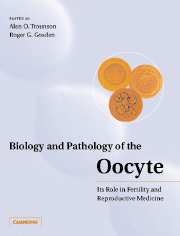Book contents
- Frontmatter
- Contents
- List of contributors
- Preface
- Part I Historical perspective
- Part II Life cycle
- Part III Developmental biology
- Part IV Pathology
- Part V Technology and clinical medicine
- 17 Growth and development of the mammalian oocyte-granulosa cell complex in culture
- 18 Human oocyte maturation in vitro
- 19 Follicular factors affecting oocyte maturation and developmental competence
- 20 Low temperature storage of follicular and ovulated oocytes
- 21 Fecundity of transplanted ovaries
- Index
21 - Fecundity of transplanted ovaries
from Part V - Technology and clinical medicine
Published online by Cambridge University Press: 05 August 2016
- Frontmatter
- Contents
- List of contributors
- Preface
- Part I Historical perspective
- Part II Life cycle
- Part III Developmental biology
- Part IV Pathology
- Part V Technology and clinical medicine
- 17 Growth and development of the mammalian oocyte-granulosa cell complex in culture
- 18 Human oocyte maturation in vitro
- 19 Follicular factors affecting oocyte maturation and developmental competence
- 20 Low temperature storage of follicular and ovulated oocytes
- 21 Fecundity of transplanted ovaries
- Index
Summary
Ovarian grafting provides a valuable research tool for studying ovarian biology, but can also be used to restore ovarian functions (reproductive hormone production and fertility). Ovarian transplantation is technically simple and can be used in clinical practice as well as for laboratory, domestic and nondomestic animal species. In the past, all clinical and most experimental work on ovarian grafting was performed using fresh tissue, but it is now evident that cryopreserved (frozen-thawed) ovarian tissue can also be auto-, alio- and/or xenografted. Importantly, the oocytes, which develop within grafts of fresh or frozen-thawed ovaries or ovarian pieces, have the ability to develop into normal live young. Ovarian grafting is, therefore, a potentially valuable tool both clinically and for the preservation of rare and endangered species. This chapter aims to show how the biology of the ovary as well as technical aspects of ovarian collection, preservation and replacement influence the outcome of ovarian transplantation.
Introduction
Ovarian grafting has for many years been a convenient experimental and practical tool for investigating, and assisting, female reproduction in a wide range of species (Table 21.1). Its efficacy is well documented as it has been used for over 50 years to propagate infertile and subfertile mouse lines (Russell and Gower, 1950; Brem et al., 1990; Cecim et al, 1995; Sztein et al, 1998, 1999). Grafts have been placed within the same animal (autografting), moved to other histocompatible recipients of the same species (alio- or iso-grafting) or to other species (xenografting).
- Type
- Chapter
- Information
- Biology and Pathology of the OocyteIts Role in Fertility and Reproductive Medicine, pp. 327 - 342Publisher: Cambridge University PressPrint publication year: 2003
- 1
- Cited by



